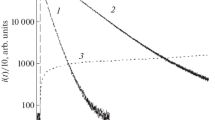Abstract
We examined the effects of Triton X-100, digitonin, sodium dodecyl sulfate, taurocholic acid, and cetylpyridinium chloride on hemoglobin-catalyzed and t-butyl hydroperoxide-induced chemiluminescence. The experimental system contained hemoglobin, luminol, t-butyl hydroperoxide, and different concentrations of detergents (5–100 mg/dl) in TRIS-HCl buffer. Control assays were performed by excluding detergents. Chemiluminescence was detected using a liquid scintillation counter in single photon mode. All concentrations chosen for each detergent reduced the maximum chemiluminescence value and retarded the time that maximum chemiluminescence occurred. The most prominent reduction in maximum chemiluminescence was observed with 50 and 100 mg/dl digitonin. The smallest reduction was observed with 5 mg/dl sodium dodecyl sulfate, without retardation of the time that maximum chemiluminescence occurred. Our aim was to use detergents in membrane-containing experimental systems and hence to identify the detergent with the least effect on chemiluminescence. Our results suggest that sodium dodecyl sulfate is the most suitable detergent for chemiluminescence studies in membrane systems.
Similar content being viewed by others
References
Helenius A, Simons K. Solubilization of membranes by detergents. Biochim Biophys Acta 1975; 415:29.
Helenius A, McCaslin DR, Fries E, Tanford C. Properties of detergents. Methods Enzymol 1979; 56:734.
Hjelmeland LM. The design and synthesis of detergents for membrane biochemistry. Methods Enzymol 1986; 124:135.
Cadenas E, Sies H. Low-level chemiluminescence as an indicator of singlet molecular oxygen in biological systems. Methods Enzymol 1984; 105:221.
Boveris A, Cadenas E, Chance B. Ultraweak chemiluminescence: a sensitive assay for oxidative radical reactions. Fed Proc 1981; 40:195.
Iwaoka T, Tabata F, Takahashi T. Lipid peroxidation and lipid peroxide detected by chemiluminescence. Free Radic Biol Med 1987; 3:329.
Gümü§lü S, Yücel G, Aydin M, Ye§ilkaya A, Demir AY, Aksu TA. The role of antioxidants in the prevention of t-butyl hydroperoxide-induced chemiluminescence. Int J Clin Lab Res. 1996; 26:119.
Gümü§lü S, Demir AY, Yücel G, Ye§ilkaya A, Aydin M, Aksu TA. Antioxidant role of bovine albumin detected by a chemiluminescence method. Turk J Med Sci. In press.
Motsenbocker MA, Oda K, Ichimori Y. Enhancer of the non-peroxidative metal porphyrin chemiluminescence reaction. J Biolumin Chemilumin 1994; 9:7.
Storch J, Ferber E. Detergent-amplified chemiluminescence of lucigenin for determination of superoxide anion production by NADPH oxidase and xanthine oxidase. Anal Biochem 1988; 169:262.
Janson JC, Ryde'n L. Protein purification. New York: VCH Publishers: 1989; 8, 423:86.
Stryer L. Biochemistry, 3rd edn. New York: Freeman 1988; 299–300.
Moore RB, Manery JF, Still J, Mankad VN. The inhibitory effects of polyoxyethylene detergents on human erythrocyte acetylcholinesterase and Ca2++Mg2+ ATPase. Biochem Cell Biol 1989; 67:137.
Yalçin AS, Sabuncu N, Emerk K. Cumene hydroperoxide-induced chemiluminescence in human erythrocytes: effect of antioxidants and sulfhydryl compounds. Int J Biochem 1992; 24:499.
Imaizumi S, Kayama T, Suzuki J. Chemiluminescence in hypoxic brain—the first report. Stroke 1984; 15:1061.
Smith JA, Baker MS, Wiedemann MJ. Free radical generation in hydroperoxide-treated erythrocytes monitored continuously by luminol-amplified chemiluminescence. Biochem Int 1992; 28:1009.
Yalçin AS, Sabuncu N, Emerk K. Chemiluminescence measurements as an indicator of cumene hydroperoxide-induced lipid peroxidation in human erythrocytes. Hematol Rev 1990; 4:147.
De Medeiros MH, Bechara EJ. Chemiluminescent aerobic oxidation of protein adducts with glycolaldehyde catalyzed by horseradish peroxidase. Arch Biochem Biophys 1986; 248:435.
Bagazgoitia FJ, Garcia JL, Diequez C, Weeks I, Woodhead JS. Effect of surfactants on the intensity of chemiluminescence emission from acridinium ester labelled proteins. J Biolumin Chemilumin 1988; 2:121.
Author information
Authors and Affiliations
Rights and permissions
About this article
Cite this article
Gumüslü, S., Erkiliç, A., Yücel, G. et al. The effects of detergents on t-butyl hydroperoxide-induced chemiluminescence. Int J Clin Lab Res 26, 203–206 (1996). https://doi.org/10.1007/BF02592983
Received:
Accepted:
Issue Date:
DOI: https://doi.org/10.1007/BF02592983




